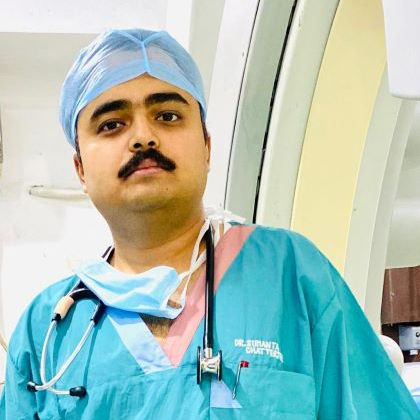Carotid Revascularisation : A Guide to Who Really Needs It
A clear guide to carotid artery surgery, explaining who needs revascularisation, the procedures involved, risks, and how to make an informed decision for stroke prevention.


Introduction
Imagine the arteries in your neck as vital pipelines supplying blood to your brain. Now, imagine those pipelines becoming clogged. This is the reality of carotid artery disease, a serious condition that significantly increases your risk of a stroke. The decision to intervene with a procedure known as carotid revascularisation is a major one. It’s not for everyone with narrowing arteries, but for the right person, it can be a life-saving stroke prevention strategy. This guide will cut through the complexity and help you understand the critical question: who needs a carotid revascularisation? We’ll break down the medical guidelines into clear, actionable information, exploring the symptoms, diagnostic thresholds, and personal health factors that doctors use to make this crucial recommendation.
Understanding Your Carotid Arteries and Why They Matter
Your carotid arteries are the main blood vessels that deliver oxygen-rich blood to your brain and head. You have two, located on each side of your neck. When you feel your pulse just under your jawline, you’re feeling your carotid artery. These arteries are essential for proper brain function. Over time, however, they can become narrowed or blocked by a buildup of fatty substances, cholesterol, and cellular waste—a process known as atherosclerosis. This buildup is called plaque.
The Link Between Carotid Artery Disease and Stroke
The primary danger of carotid artery disease isn't just the reduced blood flow itself. The real threat is what can happen to the plaque. A piece of this unstable plaque can break off (an embolism) and travel upstream into the brain, where it can get lodged in a smaller artery, blocking blood flow and causing an ischaemic stroke. Alternatively, a blood clot can form on the irregular surface of the plaque, leading to the same dangerous outcome. This is why managing carotid artery disease is fundamentally about stroke prevention.
Consult a Vascular Specialist for the best advice
The Tipping Point: When Narrowing Becomes Dangerous
Not every bit of plaque necessitates surgery. The decision to proceed with carotid revascularisation hinges on identifying a "tipping point" where the risk of a future stroke outweighs the risks of the procedure itself.
Symptomatic vs. Asymptomatic Carotid Artery Disease
This is the most critical distinction doctors make.
• Symptomatic: This means you have experienced a warning sign, such as a transient ischaemic attack (TIA) or a "mini-stroke," or a full-blown stroke. Symptoms are sudden and temporary, often lasting only a few minutes to hours, and can include vision loss in one eye, slurred speech, weakness or numbness on one side of your face or body, or dizziness. If you are symptomatic, the risk of having a major stroke in the near future is high, making revascularisation a much more urgent consideration.
• Asymptomatic: This means you have significant narrowing (stenosis) but have never experienced any related stroke-like symptoms. The blockage is often discovered incidentally during a routine physical exam when your doctor hears a "bruit" (a whooshing sound) with a stethoscope over your neck, or during a screening test for other reasons. The decision-making process here is more nuanced and depends heavily on the degree of blockage and your overall health.
Are You a Candidate? The Key Factors Doctors Consider
So, how do specialists decide? They don't rely on a single factor but rather a combination of key criteria.
The Golden Rule: Your Symptoms (or Lack Thereof)
As mentioned, this is paramount. For symptomatic patients with a blockage of 50% or more, the guidelines strongly favor carotid revascularisation (usually CEA) in addition to medication and lifestyle changes, provided the surgical risk is acceptable. The procedure is most effective when performed soon after the symptomatic event.
The Percentage of Blockage (Degree of Stenosis)
The severity of the narrowing is measured as a percentage. Generally, intervention is not recommended for blockages less than 50%. The debate intensifies for asymptomatic patients. For many years, surgery was recommended for asymptomatic men with a blockage of 60% or more. However, with significant improvements in modern medical therapy (powerful statins and blood pressure drugs), the benefit of surgery for asymptomatic individuals has narrowed. Today, it's typically considered for those with a very high-grade stenosis (e.g., 80% or more) who are otherwise healthy and have a long life expectancy.
Your Overall Health and Surgical Risk
A patient's individual health profile is a major deciding factor. A vascular surgeon will carefully assess your:
• Age and Life Expectancy: The long-term benefit of the procedure must justify the immediate risk.
• Other Medical Conditions: The presence of heart disease, lung disease, or other serious illnesses can increase the risk of complications from surgery or anesthesia.
• Anatomy: Sometimes, the location of the plaque makes one procedure safer than the other. For instance, patients who have had prior neck surgery or radiation might be better candidates for carotid artery stenting (CAS).
Carotid Revascularisation Procedures Explained
If you and your doctor decide that revascularisation is the right path, you have two main options.
Carotid Endarterectomy (CEA): The Gold Standard
This is the traditional and most common surgical procedure. A vascular surgeon makes an incision in the neck, directly accesses the carotid artery, and physically removes the plaque buildup from the artery lining. It has a long track record of success and durability. It is often considered the first-line best treatment for carotid artery disease in low-risk surgical patients.
Carotid Artery Stenting (CAS): A Less Invasive Alternative
This is an endovascular procedure, meaning it doesn't require open surgery. An interventional cardiologist or radiologist threads a catheter (a thin tube) from an artery in the groin up to the neck. A tiny balloon is inflated to open the narrowed area, and a mesh tube called a stent is permanently placed to keep the artery propped open. CAS is often reserved for patients who are at high risk for complications from open surgery due to other medical conditions or anatomical factors.
Weighing the Pros and Cons: Surgery vs. Medication Alone
For asymptomatic patients, this is the central debate. Modern medical therapy alone—aggressively managing cholesterol, blood pressure, and diabetes, along with antiplatelet drugs like aspirin or clopidogrel and lifestyle changes—can be remarkably effective at stabilising plaque and reducing stroke risk. The decision to add revascularisation is a calculated risk. The procedure itself carries a small but real risk of causing a stroke or heart attack during or shortly after the operation. Therefore, the skill of the surgeon and the hospital's success rates are critical factors. The goal is to choose the option that provides the greatest net benefit for the individual patient over the long term. If you are unsure about the best path for your condition, consult a vascular specialist online with Apollo24|7 to discuss your specific situation.
Life After Carotid Revascularisation: Recovery and Prevention
Carotid revascularisation is not a cure for atherosclerosis; it's a corrective procedure for a specific problem. The recovery time after carotid endarterectomy is typically a few weeks, with most patients returning to normal activities within a month. Recovery from stenting is often faster. Crucially, life after the procedure requires a lifelong commitment to prevention. This includes taking prescribed medications (especially statins and antiplatelets), eating a heart-healthy diet, exercising regularly, not smoking, and controlling blood pressure. Apollo24|7 offers a convenient home collection for tests like cholesterol panels and HbA1c to help you monitor your health effectively.
Conclusion
Navigating the decision for carotid revascularisation can feel overwhelming, but understanding the key principles—symptoms, stenosis percentage, and overall health—empowers you to have an informed conversation with your healthcare team. This procedure is a powerful tool in the stroke prevention arsenal, but it's reserved for situations where the potential benefits clearly outweigh the risks. For many, especially those without symptoms, aggressive medical management has become an incredibly effective strategy. The most important step you can take is to be proactive. If you have risk factors for vascular disease, such as high blood pressure, high cholesterol, or a history of smoking, regular check-ups are vital. If you experience any warning signs of a TIA, seek immediate medical attention. Ultimately, the path to protecting your brain health is a partnership between you and your doctors, combining the right interventions with sustainable lifestyle choices for long-term well-being.
Consult a Vascular Specialist for the best advice
Consult a Vascular Specialist for the best advice

Dr. Bhethala Sharan Prakash
General Physician/ Internal Medicine Specialist
5 Years • MBBS MD
Bengaluru
PRESTIGE SHANTHINIKETAN - SOCIETY CLINIC, Bengaluru

Dr. Anand Ravi
General Physician
2 Years • MBBS
Bengaluru
PRESTIGE SHANTHINIKETAN - SOCIETY CLINIC, Bengaluru

Dr. Dayanashre N
General Physician
3 Years • MBBS
Bengaluru
PRESTIGE SHANTHINIKETAN - SOCIETY CLINIC, Bengaluru

Dr. Sumanta Chatterjee
Cardiologist
12 Years • MBBS,MD General Medicine,DM Cardiology
Kolkata
HealthYou Speciality Clinic & Diagnostics., Kolkata
(25+ Patients)

Dr. Zulkarnain
General Physician
2 Years • MBBS, PGDM, FFM
Bengaluru
PRESTIGE SHANTHINIKETAN - SOCIETY CLINIC, Bengaluru
Consult a Vascular Specialist for the best advice

Dr. Bhethala Sharan Prakash
General Physician/ Internal Medicine Specialist
5 Years • MBBS MD
Bengaluru
PRESTIGE SHANTHINIKETAN - SOCIETY CLINIC, Bengaluru

Dr. Anand Ravi
General Physician
2 Years • MBBS
Bengaluru
PRESTIGE SHANTHINIKETAN - SOCIETY CLINIC, Bengaluru

Dr. Dayanashre N
General Physician
3 Years • MBBS
Bengaluru
PRESTIGE SHANTHINIKETAN - SOCIETY CLINIC, Bengaluru

Dr. Sumanta Chatterjee
Cardiologist
12 Years • MBBS,MD General Medicine,DM Cardiology
Kolkata
HealthYou Speciality Clinic & Diagnostics., Kolkata
(25+ Patients)

Dr. Zulkarnain
General Physician
2 Years • MBBS, PGDM, FFM
Bengaluru
PRESTIGE SHANTHINIKETAN - SOCIETY CLINIC, Bengaluru
More articles from Carotid Arteries
Frequently Asked Questions
1. What percentage of carotid blockage requires surgery?
There's no single percentage that automatically mandates surgery. For symptomatic patients, surgery is often recommended for blockages over 50%. For asymptomatic patients, it's typically considered for severe blockages (e.g., 80% or more) in otherwise healthy individuals, but this must be carefully weighed against the success of medication therapy.
2. What is the life expectancy after a carotid stent?
Life expectancy after a successful carotid stent is generally good and primarily depends on managing your overall cardiovascular health. The stent itself addresses a specific blockage, but your long-term health relies on controlling underlying conditions like hypertension and cholesterol through medication and lifestyle, which can allow for a normal life expectancy.
3. What are the symptoms of a clogged carotid artery?
Often, there are no symptoms until a TIA or stroke occurs. Warning signs of a TIA, which indicate a potentially clogged artery, include sudden temporary weakness/numbness on one side of the body, slurred speech, dizziness, and vision loss in one eye. These require immediate medical evaluation.
4. What is the difference between CEA and CAS?
Carotid endarterectomy (CEA) is open surgery to remove plaque directly. Carotid artery stenting (CAS) is a less invasive procedure that uses a catheter to place a stent and widen the artery from the inside. CEA is often the first choice for low-risk patients, while CAS may be preferred for those at high surgical risk.
5. Is carotid revascularisation a major surgery?
Carotid endarterectomy (CEA) is considered a major surgical procedure. While it is commonly performed and very safe in experienced hands, it does carry risks like any major operation. Carotid artery stenting (CAS) is less invasive but still a significant procedure with its own set of risks.
